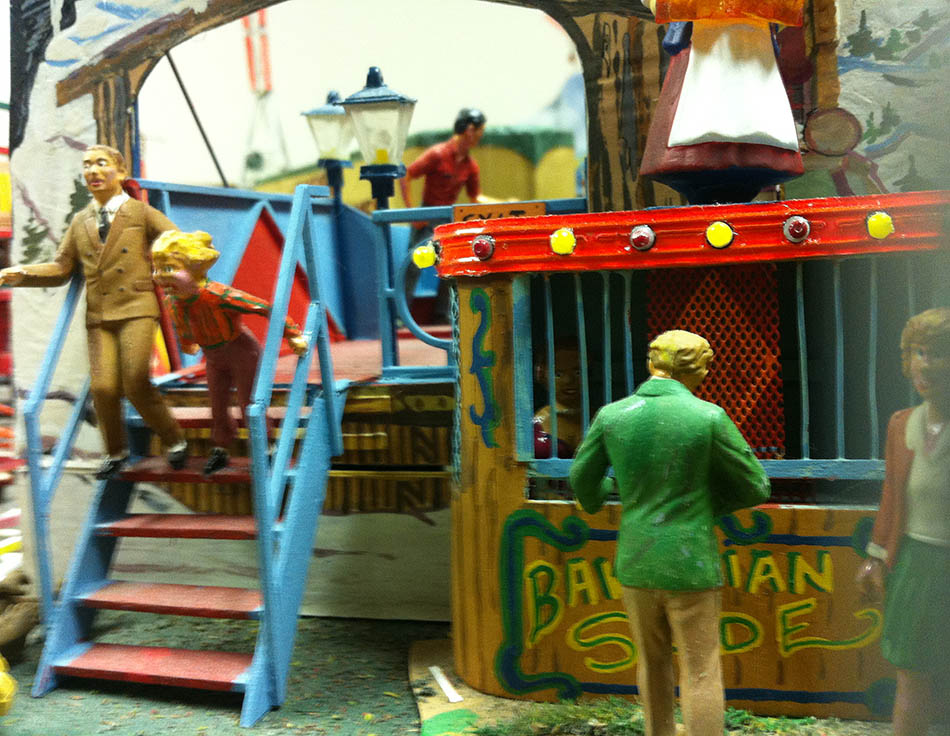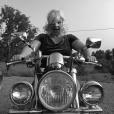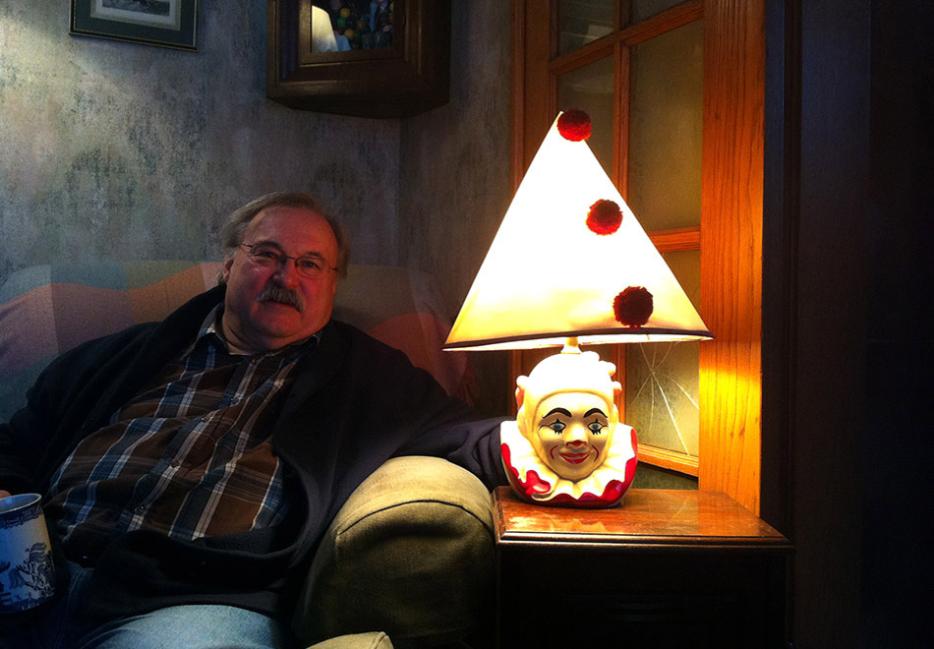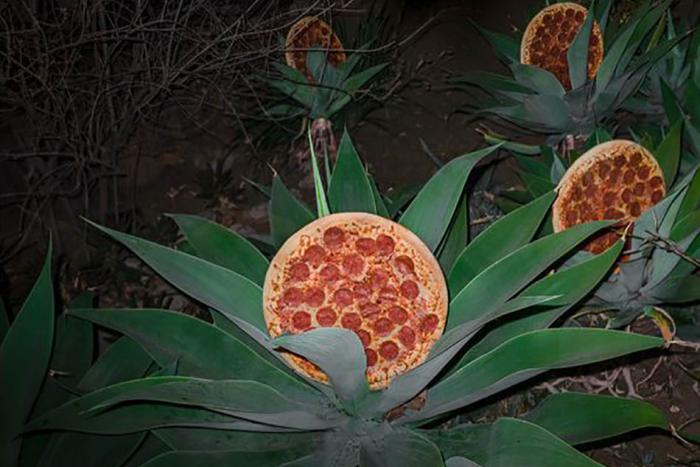When I was a little girl, I wanted to be a clown when I grew up. But I had no clue how to become a real clown or how to join a circus. If only I had known Al Stencell back then.
I recently met Stencell at the launch for my novel All the Broken Things. It’s about a 14-year-old Vietnamese boy who is recruited to wrestle bears on the carnival circuit. For the launch I wanted to hang a banner like the ones you’d see at old freak shows, so the organizers had Stencell contribute two banners from his collection; then he kindly stayed for my launch. When I spoke to him after the event he told me that he was 12 years old when he began working the circuit. I felt as if I had met a person just like the protagonist of my own novel.
I interviewed Stencell at his home in Toronto’s east end. The house is situated on a short, charming block, and doesn’t register as anything different even though in fact it is a portal into another world. Inside, every wall displays circus-related art; everywhere I looked I saw reminders of his life in the circus. Pleasantly portly, cardigan-wearing, and mustachioed, Stencell looks like your favourite uncle, and the sort of guy you wouldn’t pay much notice on the subway. And like his house, he hides treasures. The man’s brain is filled with carnival and circus recollections; he has even written two books about his life, Circus and Carnival Ballyhoo and Seeing is Believing. We sat in Stencell’s living room and I began by asking him to tell me about his first experience with the carnival world.
Stencell: I grew up in Perth Ontario and I wanted to get the hell out of there! It was the most boring place on earth... for me, anyways. It was just a very small town. My father ended up in a wheelchair, and so my mother had to go out and work. In the winter, she would drop me at the ice rink, and she would clean people’s houses and offices and stuff and come back and pick me up at like 10 o’clock at night.
I liked shows and what an exciting time of the year it was when the fair came. I kept hanging around the fairgrounds and then finally this guy gave me a job in a Hoopla joint [the ring toss midway game]. After four days I came to get paid and he just told me to fuck off, right? I thought, “Oh, this is exciting!”
Even before he joined the carnival circuit, Stencell was already something of a circus ringmaster, running his own show: he had trained his dogs to jump through hoops and run a course for the neighbours. But his big-time break came when he was 13.
The next year I went over to the fair and the owner of the carnival and this other guy were having a fight about its usual location. He said, “Oh, I’m pretty sure it was over here,” and I’m sitting there straddling my little bike and I said, “ Oh no, I think it was over there,” and he said to me, “What the fuck do you know, kid?” And I said, “Well, I made a map.” He said, “A what? A map?” I said, “Yeah, I drew a sketch of where everything was.” He said, “Where is it?” I said, “At home.” “How far do you live from here?” “Six blocks.” He said, “Go home and get that sketch!”
So I bicycle home and come back. I give it to this guy and—these are tough carnies, right? All of a sudden there’s like a half dozen of them huddled around this thing, like it’s an official statement. Then the guy goes, “Here, Asshole! Your joint’s right over there like the kid said, look it, it’s down right here on the map!” The guy says, “Oh, okay.” He hands it back to me and he asks, “Hey, you want a job?” I said sure. He took me over to his wife at the candy floss trailer and said, “Heidi put him to work! He’s pretty cool. He knows all about this business. He’s got a map. He knows where everything is!”
At the end of the engagement, they said, “If we send you a bus ticket, can you come to next week’s spot for the weekend?” I worked the entire circuit with that show [on weekends] until we finally ended up in Markham, and they said, “Well as soon as you get out of school, phone us, and we’ll tell you where we are and you can come and stay for the summer.” So I asked my parents if I could go and my father thought that would be a good idea, it’d be adventurous; my mother was a little concerned but they finally said, “Oh...yeah, okay.”

I try to place myself at 13 years old sleeping in a trailer and working alongside the tough carnies Stencell impressed with his map-making skills. In my teens I hung out with the carnies at the Metcalfe Fair outside Ottawa—smoking cigarettes and pretending to be older than I was. I remember the girl who ran the Hoopla game. She wore a long fitted denim coat and was the most beautiful, poised, empowered woman I had ever met. She was dirty and wild. Maybe Stencell was there.
Stencell is 67 or 68 now (he can’t remember) and he seems to always have known what he wanted to be. During the first full summer of working with the carnival, he read a trade magazine called Amusement Business and wrote letters to circuses in the hope of getting work in one. He was 14 or so when he landed his first circus job.
Bill and Dick Garden had started a circus called Gene Cody & Kipling Brothers, and I joined it, in the spring of 1960, in Ajax. At that time the bus let you out on the highway and you walked the two miles into town. I got there in time to have the tent blow down on top of me, right? I was hired as a candy butcher—the person who sells stuff in the seats, sells hot dogs and popcorn, floss and so forth.
Then I became an electrician but I didn’t know anything about electricity, was scared shitless half the time. I slept up above the generator, which was warm anyways. I got worried they wouldn’t be able to pay me so I left in the middle of the night. They thought something had happened to me. I left the generator running and everything. I slept under a billboard out by the Highway 401. The next day I got home and my mother had a pink envelope—it was from Sells and Gray Circus. I’d written them as well. So I finished the season on Sells and Gray. I ended up with Sells and Gray pretty well each summer. I got deported once and ended back up on Gene Cody & Kipling Bros, but they went bankrupt the next year out in Assiniboine, Saskatchewan.
If I give Stencell 20 hour days, factoring that even when he was sleeping, the circus was permeating his thoughts, then by 18, he will have accumulated about 9,000 of hours of expertise just as a summer job. He was heading quickly toward mastering the high wire of running a circus.
Circuses used to have a General Agent—not so much nowadays—who had a vast knowledge of the economy in the counties, and by state. He knew the state laws, the licenses, the ins-and-outs, and the politics. And so he would worm the route around. He would fill out a huge synopsis sheet that would list everything—the police chief, the mayor, all the information about the grounds, and then all the fire department regulations, and the railroad schedule, and then list everywhere you bought stuff. Some of them might even put where all the cathouses were and everything else that show people needed to know. There used to be notes on there like “The fire chief is tough here, let Tex handle them.” And Tex would have a girl waiting for ‘im or something. So they could get the extra seating in the tent and stuff like that. And then those jobs perfectly positioned people to involve themselves in corrupt behaviour, because they knew exactly how it all fit together and what they could get away with, too.
Stencell was 25 when he began operating the first circus of his own. He spoke of the circus in the way you might expect any businessman to recount the intricacies and difficulties of running an entrepreneurial venture. The difference was that most other businesses don’t involve exotic animals, nomadic artists, hoaxsters, and “circus types,” and are not contingent on weather, population, interest, and road conditions.
I started the Royal Brothers Circus, which was a partnership with Johnny Frazier. It was your typical circus of that era. We had leased an elephant that didn’t do anything. But we had an elephant! And we had leased some pretty decent acts. Family people, you know. We actually had a Brahma bull this guy would ride around the tent and jump over these big fences. And the audience was from here to me [about two feet] from the Brahma bull. We had chimps working, too. When you think about it, it was pretty crazy! It would never be allowed now. If it was well framed and flashed, people were always curious. If we broke down on the highway in the middle of nowhere all of a sudden there’d be people. If you had an elephant, people would just come out of the woods.
I didn’t find out until we’d been partners for a few years that Johnny had gone bankrupt with about 35 circuses. Johnny just couldn’t hold on to money! He was very knowledgeable. He came from an interesting circus family that were never big-time, but one of those families that you totally relied on. There was his brother, and his sister, and between them, they did about 12 acts—wire-walking, and they were all first class show-painters, and Johnny could fix anything—not exactly perfect, but enough to get you by.

Stencell and Johnny Frazier parted ways in Ruskin, Florida when the bank refused to cash Stencell’s money order because Johnny had bounced too many cheques. Johnny was having other problems, too.
Johnny had bought another circus in partnership with his brother, and it was floundering. He’d had an elephant die at the Showtown property [a famous circus location in Gibsonton, Florida] and buried it back there in a field. But it’d come back up—they’d poured lime on it and everything trying to… of course the water table’s real high there, right? The elephant just came floating back up. So he’d pretty well burnt his bridges with the owner. He wanted him off the property.
From 1983 to 1991, Al expanded to run both an outdoor circus and an indoor one, playing ice rinks and community arenas. The logistics of moving tents and gear, a menagerie of animals, and temperamental performers for four-day stints all across Canada seems insurmountable. It must have felt harrowing at times, the line between whether the circus worked or not a kind of magical one. I asked him about the animals. There are performing bears in my novel and, of course, with the public’s increasing distaste for animal acts in circuses, I did want to know how the animals were treated. Stencell told me, “People didn’t understand that the animals were like family to their trainers. They were part of the circus, too. We lived with them.”
We actually broke the frame on the elephant trucks once heading up north to a mining town– the elephants were straddling the cracked truck and we spent all day welding it. The elephants worked at the circus, too. We made a harness for this one elephant using a fire hose, so it was soft around her. It had metal plates on the end where the chains went in back to a big hook. The idea was for her to pull the tent poles. We trained her with bread for rewards. Pretty soon she was pulling the tent up. Once I had a bloody elephant get into the water supply in Alexandria. It was okay until it took a shit. I thought it was a pond but the officials said “That’s our water supply!” So, there was always something and you never knew whether you’d get enough people in the door.
Usually anything that you put out there—if it was well framed and flashed—would do money. You know. My strategy to be sure we’d make money was to see if a town had a really active grocery store, and count the grain silos—I’d get all those books from the post office and add up all the people. “Shit, there’s 1,700 pieces of mail going into the woods, the town’s only 1,000, that’s got to be another 5,000 people.” We’d play these places that no one would ever go. If city hall was run like a circus we’d have a very successful city instead we have a disorganized city run by idiots.
After the interview, Stencell brought me to the basement to see some of his memorabilia and the miniature midway he’s built. Stencell’s basement is half full of scale models of midway rides, games, and food concessions. He told me he has been making them his whole life.
I made my first miniature circus when I was 8 or so. My parents had given me a Super Circus set for Christmas. Marx Toys was making these play sets. I later had one of the Alamo. I conscripted the figures into circus working men! The Super Circus set had various circus figures, a side show banner, and a metal big top. The metal tent didn’t look real so I set about making one of cloth and since the set had no wagons, I started cutting wagon sides out of orange crate wood on my father’s jigsaw. Later he bought me a small jigsaw. He encouraged my efforts. I can remember the first wagon I built was a bandwagon for the circus band which I placed on my lamp table beside my bed and kept waking up at various times in the night to look at it—really amazed that I had made it. Later I cut little bandsmen out of wood to go on top of it.
Later, I graduated to making a miniature carnival. I put up an old door on a table in the basement. This is where I built my first miniature carnival models with input from my dad on what he remembered seeing at the fair. I recall the smell of the paint. I managed to make a merry-go-round and was very proud of it. I set it up by the side ledge going out the back door. When I came home it was all in bits and pieces. The dog liked the glue!
I continued to build in spurts as I had time. Some years, nothing. When I got married and had my own home I put a table up in the basement and started to build in earnest again. It was a way of relieving stress from running the circus.
The miniatures sit along a table that runs the length of the room and then curves along the back wall. Looking at his work is like viewing a midway from above—the tiny Ferris wheel, tiny freak show, tiny cotton-candy vendor, and all the wee people who live there (yes, live!). They are like a fairground memory palace, each one recalling some vivid moment in Stencell’s past. As such, they are the perfect three-dimensional externalization of all he knows, and of his massive archive of original photos of early 1900s to 1970s travelling circuses and theatres, his exhaustive collection of gypsy, minstrel, freak, and circus books, as well as carnival paraphernalia, of which the freak show banners are only a portion. This world inside Al Stencell’s house, and more so, inside his brain, is a world that does not exist anymore. I asked Stencell if he thought the sort of circus he ran could work again, but he didn’t think so.
Uh-uh, not as much. I think people are more jaded and cautious than they used to be. They’re sorta—they’re too used to being ripped off now, I think. They’re too... too shy.






